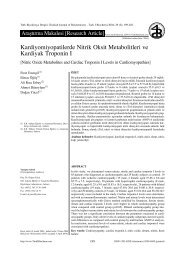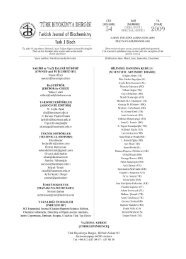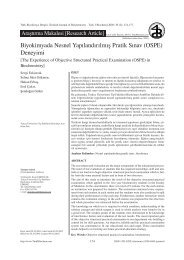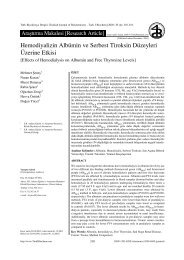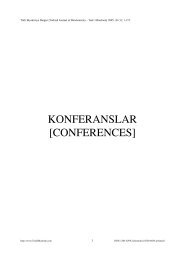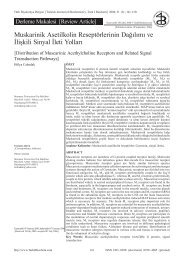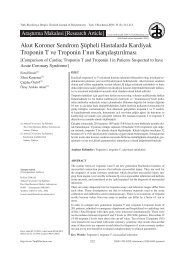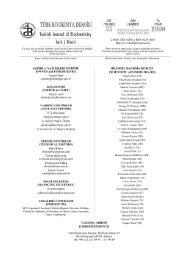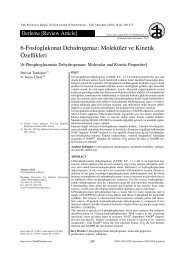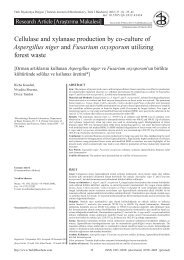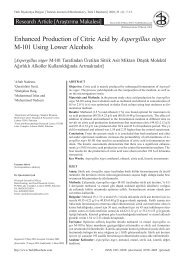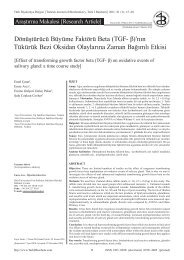24. Ulusal Biyokimya Kongresi - Türk Biyokimya Dergisi
24. Ulusal Biyokimya Kongresi - Türk Biyokimya Dergisi
24. Ulusal Biyokimya Kongresi - Türk Biyokimya Dergisi
- No tags were found...
Create successful ePaper yourself
Turn your PDF publications into a flip-book with our unique Google optimized e-Paper software.
XXIV. ULUSAL B‹YOK‹MYA KONGRES‹<br />
25 - 28 Eylül 2012<br />
Dedeman Otel - Konya<br />
<strong>24.</strong> <strong>Ulusal</strong> <strong>Biyokimya</strong> <strong>Kongresi</strong>, Konya [24 th National Biochemistry Congress, Konya / TURKEY]<br />
İÇİNDEKİLER<br />
P227 - GÖZİÇİ SIVILARINDA POSTMORTEM BİYOKİMYA<br />
PARAMETRELERİ: ZAMANIN ETKİSİ<br />
1<br />
Gülfer ÖZTÜRK, 2 M.Ziya KIR, 1 Zeynep GINIŞ, 1 Gönül ERDEN,<br />
3<br />
Mukaddes GÜRLER, 4 Sümeyya AKYOL, 5 Mehmet KAYA,<br />
6<br />
Mustafa KARAPIRLI, 7 Ömer AKYOL<br />
P227 - POSTMORTEM BLOOD CHEMISTRY PARAMETERS IN<br />
VITREOUS HUMOR: THE EFFECT OF TIME-COURSE<br />
1<br />
Gülfer ÖZTÜRK, 2 M.Ziya KIR, 1 Zeynep GINIŞ, 1 Gönül ERDEN,<br />
3<br />
Mukaddes GÜRLER, 4 Sümeyya AKYOL, 5 Mehmet KAYA,<br />
6<br />
Mustafa KARAPIRLI, 7 Ömer AKYOL<br />
CONTENTS<br />
1<br />
Ankara Dışkapı Eğitim ve Araştıma Hastanesi, <strong>Biyokimya</strong> Kliniği, Ankara<br />
2<br />
Adli Tıp Kurumu, Erzurum Adli Tıp Grup Başkanlığı, Erzurum<br />
3<br />
Adli Tıp Kurumu,Ankara grup başkanlığı, Kimya İhtisas Dairesi, Ankara<br />
4<br />
Fatih Üniversitesi Tıp Fakültesi, <strong>Biyokimya</strong> AD, Ankara<br />
5<br />
Fatih Üniversitesi Tıp Fakültesi, Halk Sağlığı AD, Ankara<br />
6<br />
Adli Tıp Kurumu, Ankara Grup Başkanlığı, Ankara<br />
7<br />
Hacettepe Üniversitesi Tıp Fakültesi, <strong>Biyokimya</strong> AD, Ankara<br />
Giriş-Amaç: Postmortem kontaminasyon ve çürümeye karşı oldukça iyi korunan<br />
göziçi sıvısı (GİS) adli patoloji ve toksikoloji alanında postmortem araştırmalarda<br />
kullanılabilmektedir. Buna rağmen GİS serumunda yapılmış detaylı biyokimyasal<br />
çalışmalar az sayıdadır. Rutin uygulamada yaygın olarak postmortem potasyum<br />
analizi ve bazı adli laboratuvarlarda hastane ölüm nedenlerinin araştırılması<br />
amacıyla glukoz, kreatinin ve keton cisimleri gibi kimyasal parametreler pratik<br />
uygulamaya dahil edilmiştir. Bu çalışmanın amacı postmortem sürede GİS serum<br />
değerlerindeki değişimleri araştırmaktır. Metod-materyal: GİS ve kan örnekleri<br />
2011 Aralık ayı ile 2012 Mayıs ayı arasında Ankara Adli Tıp Grup Başkanlığı<br />
morgunda yapılan 35 otopsi vakalarından elde edildi. Kadın ve erkek sayıları<br />
sırasıyla 11(%32.4), 24(%67.6) ve ortalama yaş 38.92±17.3 idi. Elde edilen GİS<br />
ve periferal kan örnekleri santrifüj edildikten sonra üçe bölünerek ilk kısımdan<br />
0., 15. ve 30. günlerde sodyum, potasyum, klor, kalsiyum, magnezyum, üre,<br />
kreatinin, glukoz, fosfor, albumin, kolesterol ve total protein analizleri Siemens<br />
Advia-2400 otoanalizörü ile yapıldı. Bulgular: Postmortem 30. gün GİS sodyum,<br />
glukoz, fosfor, magnezyum, potasyum ve klor değerleri 0. güne göre anlamlı<br />
ölçüde yükselmişti. Kalsiyum, kreatinin, üre, albumin, kolesterol ve protein<br />
değerlerinde zamana bağlı anlamlı farklılıklara rastlanmadı. Kan serumu ve GİS<br />
serumundaki sodyum, potasyum, klor, kalsiyum ve kreatinin değerleri arasında iyi<br />
bir korelasyonun olduğu gözlendi. Sonuç: Bu sonuçlara göre bazı biyokimyasal<br />
parametreler postmortem sürenin ve ölüm sebebinin -özellikle de hastane<br />
ölümlerinin- tespiti amacıyla rutin laboratuvar testleri arasında yer alabilir. Bir<br />
ön çalışma niteliğinde olan bu değerlendirme zamanın etkisini araştırmak ve<br />
anlayabilmek açısından daha kapsamlı ve daha uzun postmortem süreleri içeren<br />
çalışmalara ihtiyaç duymaktadır.<br />
1<br />
Department of Biochemistry, Ankara Dışkapı Education and Research<br />
Hospital, Ankara<br />
2<br />
Erzurum Branch of the Council of Forensic Medicine, The Council of Forensic<br />
Medicine, Erzurum<br />
3<br />
Department of Chemistry, Ankara Branch of the Council of Forensic Medicine,<br />
Ankara<br />
4<br />
Department of Biochemistry, Fatih University Medical Faculty, Ankara<br />
5<br />
Department of Public Health, Fatih University Medical Faculty, Ankara<br />
6<br />
Ankara Branch of the Council of Forensic Medicine, The Council of Forensic<br />
Medicine, Ankara<br />
7<br />
Department of Biochemistry, Hacettepe University Medical Faculty, Ankara<br />
Background: Vitreous humor (VH) is relatively well-protected fluid from postmortem<br />
degredation and contamination. That is why it has high utility in forensic pathology<br />
and toxicology. Although there is no detailed studies focusing on the serum chemistry<br />
parameters. As a routine application, potassium analysis in the detection of postmortem<br />
interval and in some forensic laboratories serum chemistry parameters like glucose,<br />
creatinine, and keton bodies put into practice to illuminate the reason of hospital deaths.<br />
The purpose of the present study is to evaluate the time-course changes in serum<br />
chemistry parameters in VH. Methods: VH and blood samples were collected from a<br />
total of 35 autopsies (Female 11, 32.4%, and Male 24, 67.6%; Mean age:38.92±17.3),<br />
conducted at Ankara Branch of Council of Forensic Medicine morgue between<br />
December 2011 to May 2012. After centrifugation of samples, the supernatant of<br />
the fluid were analyzed for sodium, potassium, chloride, calcium, magnesium, urea,<br />
creatinine, glucose, phosphorus, albumin, cholesterol, and total protein by using an<br />
autoanalyzer Siemens Advia-2400 on the days 0, 15 and 30 after the autopsies. Results:<br />
In VH samples, levels of sodium, glucose, magnesium, potassium, and chloride on the<br />
day 30 were found to be increased significantly when compared to the levels on the<br />
first day. The changes in calcium, creatinin, urea, albumin, cholesterol and protein<br />
levels by the time-course were not statistically significant. The correlation analyses<br />
between blood and VH samples showed a good relationship on sodium, potasium,<br />
chloride, calcium, and creatinin levels. Conclusion: The results clearly indicate that<br />
some chemistry parameters could be analysed to evaluate the postmortem interval or<br />
the manner of death, especially hospital deaths. This is a preliminary study and requires<br />
further studies to illuminate the effect of time-course in term of longer time periods.<br />
Turk J Biochem, 2012; 37 (S1)<br />
http://www.TurkJBiochem.com



